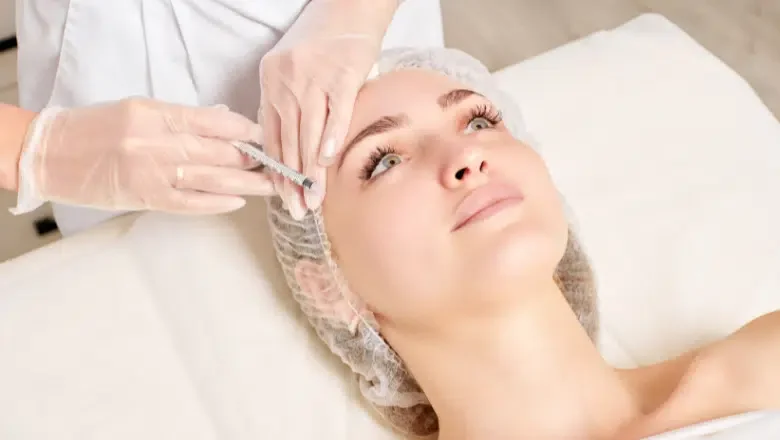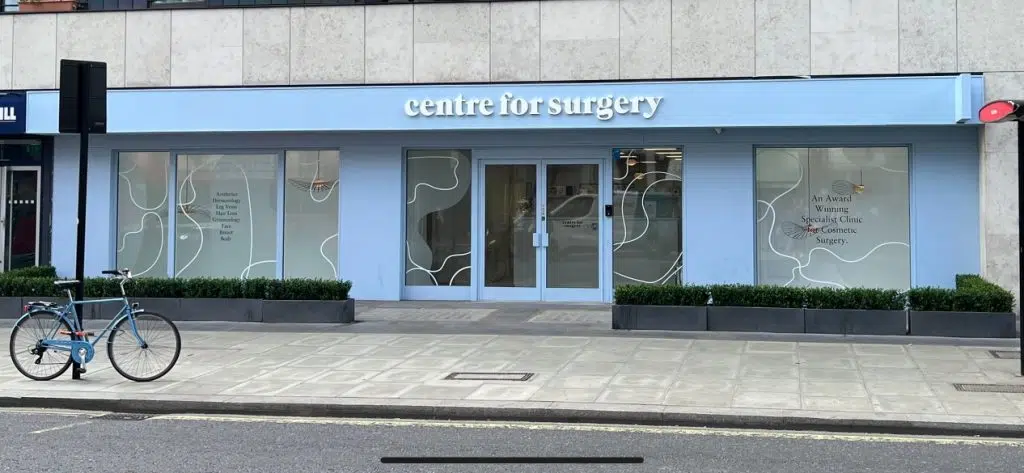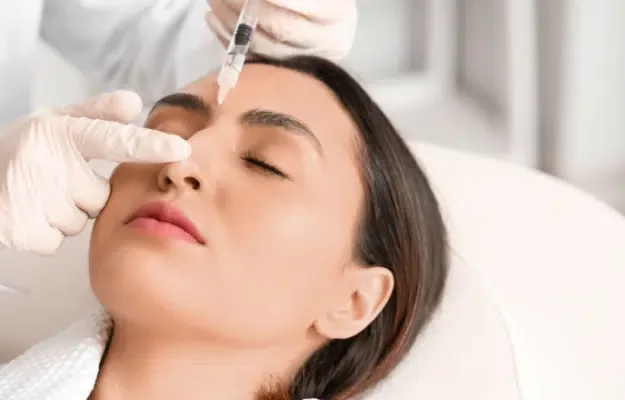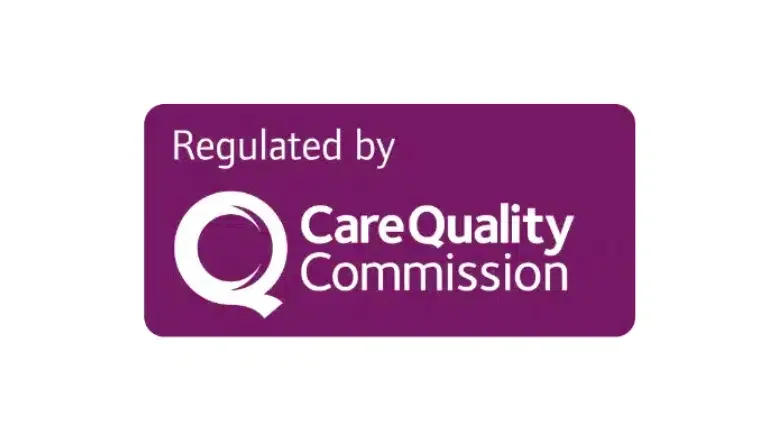Dermal Filler Dissolving Hyalase treatment
Misplacement of dermal fillers or incorrect injection locations can lead to undesired complications. However, these issues can be rectified effectively with filler dissolving treatments.
Should you encounter complications resulting from dermal filler treatments, Centre for Surgery is available to assist you. Our team comprises highly skilled specialist plastic surgeons, who frequently carry out filler dissolving treatments along with a range of other non-invasive procedures. We are located in our modern clinic on Baker Street in London, where we deliver top-tier aesthetic care.
What is Hyalase?
Hyalase is a formulation which has the capability to break down hyaluronic acid fillers. It typically takes around two weeks to see the optimal results, and the procedure may need to be repeated for the desired effect. After treatment, some individuals may experience minor side effects like redness, erythema, or a mild widening of blood vessels (vasodilation). Care must be taken while administering the Hyalase injection, as an improper dosage could potentially degrade an excessive amount of hyaluronic acid.
How Does the Hyalase Procedure Function?
When commencing a Hyalase treatment, the practitioner may initiate a skin patch test to check for any adverse reactions. To make the procedure more comfortable for the patient, a local anaesthetic may be applied. The Hyalase is then injected into the targeted areas where the dissolving of the filler is desired. Following the treatment, arranging a follow-up visit two weeks later is recommended to assess the dosage used and the resulting effects. At times, more dissolving treatment may be needed, and the procedure might need to be repeated. If this is the case, your practitioner will guide you through the next steps.
When do you need a filler dissolving treatment?
Undergoing a filler dissolving treatment becomes necessary when an initial dermal filler treatment has not produced the desired results or has led to undesirable side effects. This can be due to various reasons, including the filler being misplaced, an excessive amount of filler being used, or an allergic reaction to the filler material.
Dermal fillers are a popular cosmetic treatment used to add volume, smooth wrinkles, and enhance facial contours. However, they are not without their potential issues. Some patients may experience lumps or unevenness in the skin, prolonged swelling or discomfort, or even more serious complications like vascular occlusion, where the filler blocks a blood vessel. In some cases, patients may simply be unhappy with their aesthetic result, finding the changes to their facial features too drastic or not as expected.
In such instances, filler dissolving treatment is an effective solution. The procedure uses an enzyme which breaks down the hyaluronic acid-based filler, effectively dissolving it and allowing the body to expel the product naturally. This can restore the original appearance or prepare the area for a new, more precise filler application.
Consult a skilled practitioner comprehensively before deciding on a filler-dissolving treatment. They can assess your concerns, the condition of the filler, and the best course of action for your unique needs. This could be a full dissolution of the product or a partial correction to achieve a more pleasing aesthetic outcome.
As with any cosmetic procedure, it’s crucial to seek the advice of an experienced professional. At Centre for Surgery, we provide thorough consultations and inform you of the potential risks and benefits before proceeding with a filler-dissolving treatment.
When Can Hyalase Be Used After Fillers?
Patients should understand the appropriate timing for any follow-up treatments. Specifically, when it comes to the application of hyalase, a substance used to dissolve dermal fillers, timing plays a key role in ensuring the effectiveness and safety of the treatment.
A standard recommendation after dermal filler administration is to allow a waiting period of two to three weeks. This interval is essential as it permits the fillers to settle properly within the skin’s layers and exhibit their full effect. Observing this period also allows individuals to witness the complete results of their initial filler treatment.
However, there can be scenarios where an accelerated approach might be necessary. This is particularly true in cases where a patient experiences severe side effects or shows signs of allergic reactions after the filler treatment. In such circumstances, the use of a dissolving agent for the fillers might be recommended earlier than the standard two—to three-week waiting period.
This approach is taken to ensure the safety and well-being of the patient, as allergic reactions or severe side effects can be detrimental if not addressed promptly. In these instances, the filler dissolver acts as a corrective measure to mitigate any adverse effects caused by the dermal fillers.
Suitable candidates for Hyalase treatment
The ideal candidates for Hyalase treatment are those who have had a previous dermal filler treatment using hyaluronic acid and are unhappy with the results. This could be because they feel the result is asymmetrical, too excessive, or just not as they had envisaged.
People who are experiencing complications from a previous filler treatment, such as lumps, overfilling, or vascular occlusion, can also greatly benefit from Hyalase treatment.
However, those who are pregnant or breastfeeding, have a known allergy to treatment or any other components of Hyalase, or have an active skin infection at the injection site are not suitable candidates for the procedure.
Common areas for treatment with Hyalase
Hyalase can be used to dissolve hyaluronic acid-based fillers in a variety of areas, including but not limited to:
Lips
If the fillers have resulted in excessively large lips or an asymmetrical appearance, Hyalase can be used to correct this.
Cheeks
Sometimes fillers can make cheeks appear over-filled or unnatural, and Hyalase can be utilised to bring back a more natural appearance.
Nasolabial folds
These are the lines from the nose to the mouth corners. If fillers have caused these areas to look too plump or uneven, Hyalase can be used to dissolve the fillers.
Tear troughs
This is the area beneath the eyes. If fillers have created a puffy or lumpy appearance under the eyes, Hyalase can help to dissolve the fillers and restore a more natural look.
Nose
Non-surgical rhinoplasty using fillers can sometimes result in an unsatisfactory outcome, and Hyalase can be used to reverse these effects.
What precautions should be taken before Hyalase treatment?
Before undergoing Hyalase treatment, it’s important to take the following precautions:
Medication
You should inform your practitioner about all the medications, supplements, or herbal treatments you are currently taking. Some of these might increase the risk of bruising or bleeding at the injection site. If you’re taking blood-thinning medications, you may be advised to stop them a few days before the treatment.
Allergies
Be sure to disclose any allergies, especially if you’ve had an allergic reaction to the same treatment before or any other medicine in the past.
Infections
If you have an active skin infection or inflammation (like acne or cold sores) in the area where you plan to have the treatment, you may need to postpone it until it’s healed.
Skin Care
You may be advised to avoid using certain skincare products, particularly those containing retinol or glycolic acid, a few days before the treatment.
Alcohol and Smoking
You should avoid alcohol and smoking at least 24 hours before the procedure, as these can increase the risk of complications.
Hydration
Stay well-hydrated before the procedure. This can help promote healthy recovery.
What is the Filler Dissolving Procedure with Hyalase?
The filler dissolving procedure using hyalase is a relatively straightforward and quick process.The filler dissolver breaks down hyaluronic acid, which is the main component of most dermal fillers. When injected, it effectively dissolves the filler, returning the skin to its pre-filler state.
The procedure typically involves the following steps:
Consultation
During the initial consultation, the practitioner assesses the areas where filler needs to be dissolved. They will discuss your goals, the potential risks and benefits, and the expected results of the treatment.
Preparation
The skin is cleansed, and a numbing cream may be applied to ensure comfort during the treatment.
Injection
The injection is mixed with a saline solution to create an injectable substance. It’s then injected into the same areas where the original dermal filler was placed.
Dissolving
Once injected, the enzyme quickly starts to dissolve the hyaluronic acid. Some patients may see results immediately, but typically it takes a few days for the full effects to be noticeable.
After treatment
The patient can usually return to their regular activities immediately, although some minor side effects such as redness, swelling, or tenderness may occur. These typically subside within a few days.
HA filler dissolver only works on hyaluronic acid-based fillers. It won’t dissolve fillers made of other materials. Additionally, while it is generally safe and well-tolerated, potential side effects and risks should be discussed with your practitioner during your consultation.
Aftercare instructions after Hyalase injections
Following your Hyalase treatment, it’s crucial to give your body the care and attention it needs to heal beautifully. By adhering to these straightforward aftercare instructions, you can ensure the best possible outcomes and enjoy the full benefits of your treatment. Here’s what you need to keep in mind:
Be Gentle with Your Skin
For the first 6 hours after treatment, avoid touching or rubbing the area that received treatment. This helps prevent the Hyalase from moving to unintended areas, ensuring it works exactly where it’s needed.
Keep Away from Heat
High temperatures can be your skin’s enemy right now. For two weeks after your treatment, steer clear of saunas, hot tubs, and direct, prolonged sun exposure. These can increase swelling and discomfort, so staying cool and protected is best.
Hydration is Key
Drinking plenty of water is good for your overall health and essential for helping your body process Hyalase effectively. Keep a bottle of water handy and sip throughout the day.
Take it Easy
Although staying active is generally good for you, it’s wise to pause any strenuous exercise for at least 24 hours following your treatment. This can significantly reduce the risk of bruising and swelling, helping you feel better faster.
Care for Your Skin
You can return to your usual skincare routine the day after the procedure. However, products containing retinol or glycolic acid should be avoided for a week to avoid irritating the treated area.
Limit Alcohol and Avoid Smoking
Alcohol and smoking can hinder your healing process. It’s best to avoid alcohol completely for 24 hours after treatment and to consider quitting smoking altogether to support your body’s recovery and overall health.
Check-in with Your Practitioner
Your follow-up appointment is a critical part of your treatment journey. It allows your practitioner to assess your healing progress and address any questions or concerns you might have.
How Soon Can I Expect To See Results?
After undergoing filler dissolving treatment with Hyalase, you can expect a reduction or complete removal of the initial filler. The exact outcome will depend on how much filler was initially injected, the type of filler used, and the location of the treatment.
Immediately after the treatment, you might notice some swelling, redness, or tenderness at the injection site. These are common side effects and usually subside within a few days.
The Hyalase starts to break down the hyaluronic acid filler immediately, but the results might not be visible right away due to the swelling. Generally, you can expect to see the final results within 1-2 weeks after the treatment. During this time, the filler will have dissolved and the swelling will have subsided, revealing the new contours of the treated area.
Some people might need more than one session to achieve their desired result. Always discuss your expectations with your doctor before the procedure to ensure you have a clear understanding of what the outcomes may be.
Remember, if you’re unhappy with the results after the filler has been dissolved, you can discuss having the area re-treated with dermal fillers with your practitioner. It’s usually best to wait at least two weeks after the filler dissolving treatment before having more filler injected, to ensure all swelling has subsided and the Hyalase has fully taken effect.
Potential Complications after filler dissolving treatment
While filler-dissolving treatments are generally safe, as with any procedure, there can be potential complications. Some of these include:
Allergic reactions
Some patients may have an allergic reaction to Hyalase, which is why a skin patch test is often performed prior to treatment. Symptoms can include itching, redness, or swelling at the injection site.
Over-correction
In some cases, more filler might be dissolved than intended, leading to an underfilled appearance. Once the effects of hyalase have worn off, this can be corrected by injecting more filler.
Infection
Any time the skin is broken, there is a risk of infection. Proper pre- and post-care instructions usually minimise this risk.
Bruising, swelling and redness
These are common side effects following any injectable treatment and usually resolve on their own within a few days.
Uneven results
There can sometimes be uneven results if the Hyalase doesn’t fully dissolve the filler in all areas. This can usually be corrected with a follow-up treatment.
Pain or discomfort
Some people may experience pain or discomfort at the injection site.
How Much Does Filler Dissolving Treatment Cost in London?
At Centre for Surgery, the initial price for treatments begins at £350. This cost can change based on several factors. The primary considerations include the number of areas you wish to have treated and their size. Each person’s needs are unique, and therefore, the treatment plan and its cost are customised accordingly.
To determine the precise cost of your treatment, a personal consultation with one of our specialist doctors is essential. During this consultation, the doctor will thoroughly evaluate your specific requirements. This includes understanding the areas in which you wish to be treated and any particular concerns or goals you might have. Based on this detailed assessment, the doctor will create a treatment plan that is exclusively tailored to you.
This tailored plan ensures that your individual needs are met and provides you with a clear and exact cost estimate for the treatment. This approach ensures there are no surprises regarding treatment expenses and allows you to make an informed decision about proceeding with the treatment at the Centre for Surgery.
Choose Centre for Surgery for Filler Dissolving Injections
Choosing Centre for Surgery for your filler dissolving injections is an excellent decision for several reasons:
Expertise
Our specialist plastic surgeons have extensive experience and expertise in non-invasive procedures such as filler dissolving treatment. They are skilled at assessing the precise amount of Hyalase required to dissolve the filler without harming your natural hyaluronic acid.
Personalised Approach
We believe in tailoring each treatment to the individual patient. We ensure that every aspect of your treatment, from the initial consultation to aftercare, is personalised to your specific needs and expectations.
Patient Care
We take pride in our exceptional patient care. Our dedicated team will guide and support you throughout your journey, ensuring that you are well-informed, comfortable, and confident in your treatment decisions.
Safe and Comfortable Environment
Our state-of-the-art clinic at Baker Street, London, is designed to provide a safe, clean, and comfortable environment for all our treatments.
Comprehensive Aftercare
We provide thorough post-treatment care to ensure your recovery is smooth and the results are successful. This includes regular follow-up appointments and direct access to our team for any questions or concerns.
Your Next Steps:
Research Thoroughly
- Explore our website, delve into the Procedure Pages and Blogs that are pertinent to your planned procedure.
- Browse our extensive FAQs, including those on how to choose your surgeon
- Learn about the potential risks and complications associated with your chosen surgery.
- Download and thoroughly read our comprehensive Guides to Surgery
Prepare for Your Consultation with the Plastic Surgeon
- Consider bringing a friend or family member to help discuss the information and your options
- Take comprehensive notes and diligently read the provided documents
- Dress in uncomplicated clothing as you might need to undress for a physical examination
- Bring any necessary medical referral and any relevant medical documents or test results
- Arrange Your Initial Surgery Consultation
- Secure your consultation at our Baker Street clinic by paying the Cosmetic Consultation Fee
Please contact us to book a consultation with a Specialist Plastic Surgeon or to converse with our Patient Care Advisor.
You can email us or call on 0207 993 4849 to arrange your surgeon consultation appointment.
FAQs
-
Why do I need a filler dissolving procedure?There are several reasons why you might need a filler dissolving procedure, such as:
Dissatisfaction with results: If you're unhappy with the aesthetic outcome of your dermal filler procedure, you may wish to have the filler dissolved. This could be due to an overfilled appearance, asymmetry, or simply not liking the change in your appearance.
Lumps or irregularities: Sometimes, dermal fillers can lead to lumpiness or irregularities in the skin. This could be due to the filler not being evenly distributed, or your body's reaction to the filler.
Overcorrection: If too much filler has been used, you may end up with an overcorrected, unnatural look. In these cases, filler dissolving can help to restore a more natural appearance.
Migration: In some cases, fillers can move from the initial injection site over time, leading to a distorted appearance.
Complications: In rare cases, complications such as vascular occlusion can occur, where the filler blocks a blood vessel. This is a medical emergency and requires immediate treatment, often including the use of a filler dissolving agent like Hyalase. -
How Long Does the Effect of Hyalase Last?Hyalaseis a treatment used to dissolve dermal fillers, and its effects can last for up to five days following the injection. During this period, the substance works to progressively break down the fillers.
-
Can Hyalase Dissolve All Types of Dermal Fillers?Hyalase is effective in dissolving fillers that are based on hyaluronic acid, such as Juvederm and Teoxane. However, it does not have the same effect on fillers made from different chemicals or substances, like Sculptra and Ellanse, which are not hyaluronic acid-based.
-
Does hyalase have the potential to dissolve skin tissue?Hyalase does not dissolve skin tissue. While it is effective in breaking down hyaluronic acid within the body, it does not have an impact on the tissues themselves. Consequently, it specifically targets the unwanted filler material without causing damage to surrounding tissues.
-
Can I have filler re-injected into the same area after a filler dissolving procedure?Yes, once the hyaluronic acid filler has been fully dissolved, which usually takes around two weeks, you are able to receive another filler injection in the same area. Often, people use filler dissolving treatments to adjust or correct previous filler placements, enabling them to have a refreshed filler application in the desired location after two weeks.
-
What Are the Most Common Areas for Treatment?The areas that are most frequently treated are those where dermal fillers are commonly applied. These include the lips, cheeks, nasolabial folds, tear troughs, and the nose.
-
Why is filler dissolving treatment preferred?Filler dissolving treatments are preferred due to their use of naturally occurring substances, minimising the risk of allergic reactions. However, to ensure safety, a skin patch test may be conducted by your specialist to test for any sensitivity or allergic reactions.
-
Do I need to repeat the Hyalase treatment?There are cases where patients may need to repeat the Hyalase treatment, depending on how the filler responds to the initial procedure. You may need another treatment after a couple of days or weeks to fully restore the filler area to its natural state.
-
How Many Treatments Are Recommended?The number of sessions required can vary from one individual to another. At Centre for Surgery, the approach to determining the number of treatments is patient-focused and results-driven. Here’s how the process typically unfolds:
Initial Treatment and Observation:
Assessing the Initial Treatment: After your first treatment, it’s crucial to allow some time for the effects to manifest fully. This period is important to observe how much of the dermal filler has been dissolved and to assess the changes in the treated areas.
Patient's Response to Treatment: Each individual’s response can differ. Some may see their desired results after just one session, while others might require additional treatments to achieve their aesthetic goals.
Follow-Up and Potential Additional Sessions:
Scheduling a Follow-Up Consultation: If there is still noticeable dermal filler remaining after the initial treatment, you will be advised to schedule a follow-up consultation. This appointment is an opportunity to evaluate the results of the first session and decide on the next steps.
Deciding on Further Treatment: During the follow-up, if it's determined that additional treatment is needed, your practitioner will discuss this with you. The decision to proceed with further treatments is made based on your individual needs, the amount of filler remaining, and your overall satisfaction with the results so far.
Tailoring the Treatment Plan: Any additional treatments will be tailored just like the initial one, taking into account the specific areas that need attention and the desired outcome. -
Is the Hyalase treatment considered safe?The Hyalase treatment is typically deemed safe when administered by an experienced professional such as a specialist plastic surgeon. Due to the expertise required to correctly administer these injections, not all clinics offer this treatment.
-
Are There Any Side Effects Associated with Filler Dissolver?After a Hyalase injection, you may experience some common side effects such as minor bruising and slight discomfort. These are temporary symptoms which usually resolve themselves after a few days.
-
How can I dissolve lip filler?If you wish to dissolve lip filler, the procedure involves using a Hyalase injection to break down the hyaluronic acid filler. The enzyme in Hyalase starts to dissolve the filler right after the treatment, and within two weeks, your lips should revert to their pre-treatment appearance.
-
Will my lips return to their natural state after dissolving fillers?The duration of the dissolving process is dependent on your metabolism. On average, it takes about two weeks for the Hyalase to fully dissolve in your skin. Once this happens, your lips should return to their natural state.
-
Can the Hyalase treatment cause pain in the lip area?While it is not a particularly painful procedure, the process of dissolving filler might be uncomfortable, especially in the lip area. The lips are sensitive due to the high concentration of nerve endings found in this region. Therefore, the needle used to inject the Hyalase may cause some minor discomfort.
-
Can nose filler migrate?While rare, there is a possibility that filler can migrate from the injection site to surrounding areas of the body. If this occurs, it can typically be resolved using Hyalase treatment.
-
When can I have filler re-injected after a Hyalase treatment?It is usually recommended to wait at least two weeks after a Hyalase treatment before receiving any additional filler injections. If you proceed with a filler application too soon, the enzyme could potentially break down the newly injected filler.
-
Can Hyalase treatment cause swelling?After a Hyalase treatment, it is common to experience minor swelling. However, this side effect usually resolves itself after a few days and doesn't prevent you from returning to your normal routine.
-
Is There an Alternative to Dissolving Filler?Dermal fillers naturally degrade over time and lose their volume-enhancing effects. For individuals who prefer not to use filler dissolver, the alternative is simply to allow the body to naturally break down and absorb the dermal filler material over time.
-
When Is Hyalase Not Recommended?Hyalase is not recommended for individuals with a history of severe allergies, such as anaphylaxis, or for those who are allergic to bee or insect stings. In such cases, the use treatment may pose significant health risks.
What To Expect
Initial Consultation
When you book your initial consultation at Centre for Surgery for a dermal filler dissolving treatment, you are embarking on a carefully tailored journey towards addressing your aesthetic needs. This initial consultation is a pivotal step in ensuring that the treatment you receive is perfectly aligned with your individual requirements and expectations. Here's what you can expect during this consultation:
Thorough Assessment of Aesthetic Concerns: Your practitioner will conduct a detailed examination of the areas where you have received dermal fillers. This assessment is not just about understanding the physical aspects of the filler but also involves discussing your personal aesthetic goals and concerns. The aim is to gain a comprehensive understanding of what you hope to achieve through the dissolving treatment.
Determining Suitability for Treatment: Not every individual is a suitable candidate for treatment. Your practitioner will evaluate various factors, including your medical history, any known allergies (particularly relevant since it is not suitable for individuals with certain allergies), and the type of dermal filler previously used. This step is crucial to ensure that the treatment is safe and effective for you.
Creating a Bespoke Treatment Plan: Based on the assessment and your suitability for the treatment, the practitioner will then devise a treatment plan tailored specifically to you. This plan will detail the approach to be taken for dissolving the filler, including the amount of enzyme to be used, the number of sessions required, and any other relevant details.
Providing a Full Cost Breakdown: After your treatment plan has been established, you will be given a detailed breakdown of the costs involved. This transparency is key to helping you make an informed decision. The cost breakdown will include all aspects of the treatment, ensuring that there are no hidden fees or surprises.
How To Prepare
Ahead of your treatment at Centre for Surgery, there are specific guidelines you should follow to ensure the best possible outcome and a smooth recovery. These guidelines are designed to minimise risks and enhance your comfort during and after the treatment. Here's what you need to know:
Pre-Treatment Precautions:
Avoid Alcohol and Ibuprofen: In the 48 hours leading up to your treatment, it's important to steer clear of alcohol and Ibuprofen. Alcohol can increase the risk of bruising and swelling, while Ibuprofen, being a blood thinner, can also increase bleeding and bruising risks.
Vaccine Schedule: It is crucial to avoid scheduling any vaccines for three weeks before and after your treatment. This precaution is taken to prevent any potential interactions between the treatment and the vaccine that could affect your immune response or the efficacy of the vaccine.
Managing Cold Sores: If you have a history of cold sores, especially around the treatment area, please contact Centre for Surgery for advice before your appointment. Certain precautions may be necessary to prevent a flare-up triggered by the treatment.
Treatment
When undergoing a treatment at Centre for Surgery, you'll find that the procedure is straightforward and designed with your comfort in mind. Here's what you can expect:
Anaesthesia and Comfort Measures:
No General Anaesthetic Required: Typically, treatments do not necessitate the use of general anaesthesia. This is due to the minimally invasive nature of the procedure and the relatively low level of discomfort associated with the injections.
Option for Numbing Cream: Understanding that each patient's pain threshold varies, Centre for Surgery offers the option of applying a numbing cream to the treatment areas. This topical anaesthetic helps to minimise any discomfort you might feel during the injection process. The decision to use numbing cream can be discussed and made during your consultation or before the procedure, based on your comfort level and preference.
The Injection Process:
Targeted Injections: The amount and specific sites of the injections are determined based on the assessment made during your consultation, focusing on areas where you wish to reduce or reverse the effects of the filler.
Dissolving the Dermal Filler: Once injected, hyalase works by breaking down the hyaluronic acid in the dermal fillers. This process leads to a reduction or complete reversal of the filler's volume-enhancing effects.
Quick and Efficient: The injection process is typically quick, and patients often notice results in the days following the treatment.
Aftercare Process
Post-treatment care is a vital aspect of the hyalase treatment process. To ensure a smooth and effective recovery, Centre for Surgery recommends the following steps:
Immediate Post-Treatment Care:
Avoid Makeup and Touching the Treated Area: For the first 12 hours after your treatment, it's important to avoid applying makeup and touching the treated area. This precaution helps to significantly reduce the risk of infection.
Refrain from Alcohol, Exercise, and Anti-Inflammatory Medications: For 48 hours following the treatment, you should avoid consuming alcohol, engaging in exercise, and taking anti-inflammatory medications like Ibuprofen. These measures are crucial to minimise swelling and bruising in the treated areas.
Specific Post-Treatment Practices:
Sleeping Position: Try to sleep with your head slightly elevated for the first week after the treatment. This position helps in reducing swelling and ensures that there's no undue pressure on the injected sites, allowing them to heal properly.
Managing Exposure to Extreme Conditions: For 2 weeks post-treatment, it is advisable to avoid extreme sun exposure, very cold temperatures, and activities such as firm massages or facial treatments. Additionally, staying away from steam rooms and saunas during this period is recommended. These measures help in reducing the risk of complications and ensure optimal healing.
Gentle Skincare: Adopt a gentle skincare routine that doesn't irritate the treated areas. If you're unsure about which products to use, feel free to consult with your practitioner for recommendations.












